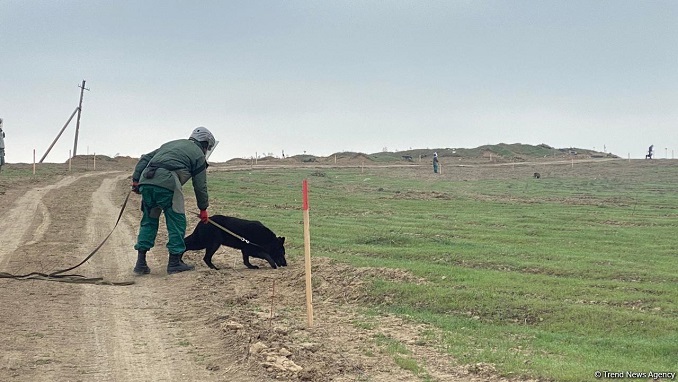An official from the Azerbaijani Mine Action Agency has said that demining operations are currently underway in areas where communications will be laid, MENA FN reports.
“The main goal at the moment is to demine the areas designated for laying gas, water supply, power transmission lines, as well as building railroads and highways,” Azar Huseynov, a specialist from the agency, said.
He added that the Armenian armed forces chaotically mined Azerbaijani territories during the years of occupation. He underlined that while withdrawing from the Azerbaijani lands during the 44-day war in 2020, the Armenian soldiers installed all available mines on the territories.
“Many mines have been installed on the pastures of Fuzuli region’s Alkhanly village. These lands had been kept under occupation for 30 years,” he said.
Azerbaijan liberated Fuzuli region from Armenia’s occupation during the war that lasted from late September through early November 2020.
Meanwhile, the head of the operational headquarters of the agency Idris Ismayilov said that the agency found and neutralized hundreds of mines and unexploded ordnance on the Azerbaijani territories liberated from the Armenian occupation since September 27, 2020 up till now.
‘An area of 17 million square kilometres has been cleared of mines and unexploded ordnance. Until today, four employees of the agency were wounded during the demining process. Moreover, 29 civilians were wounded in mine explosions, he added.
The agency’s representative, Madat Mammadov, earlier said that the absence of maps of minefields makes it difficult to find mines on the liberated territories. He noted that Armenia has not yet given the minefield maps to Azerbaijan.
‘Demining of the Azerbaijani liberated territories is the most pressing issue that is under the close scrutiny of the Azerbaijani government. Armenia did not provide us with maps of mined territories, which complicates the search for mines, Mammadov said.
Some experts believe that Armenia has spent $350 million to mine lands in and around Azerbaijan’s Nagorno-Karabakh region that were liberated from occupation in the 44-day war.
Azerbaijani President Ilham Aliyev on February 26 described Armenia’s failure to provide the maps of mined areas in liberated lands as the main difficulty for Azerbaijani IPDs to return to their homes. He said that this can also be considered to be a war crime as several servicemen and civilians were killed in mine blasts on liberated territories after the war.
Earlier, Russian military expert Igor Korotchenko said that increased political, diplomatic pressure on Yerevan will force it to give maps of minefields to Azerbaijan.
The hostilities between Azerbaijan and Armenia resumed after that latter started firing at Azerbaijani civilians and military positions starting September 27, 2020. The war ended on November 10 with the signing of a trilateral peace deal by the Azerbaijani, Russian and Armenian leaders.
The peace agreement stipulated the return of Azerbaijan’s Armenian-occupied Kalbajar, Aghdam and Lachin regions. Before the signing of the deal, the Azerbaijani army had liberated around 300 villages, settlements, city centres and historic Shusha city. The Azerbaijani army declared a victory against the Armenian troops. The signed agreement obliged Armenia to withdraw its troops from the Azerbaijani lands that it has occupied since the early 1990s.
